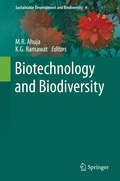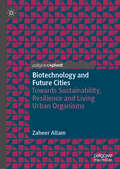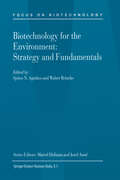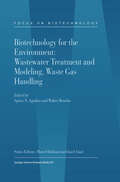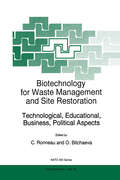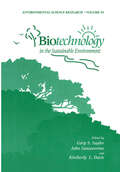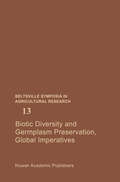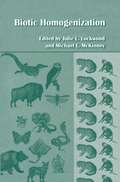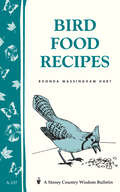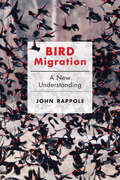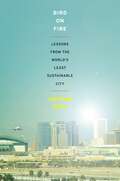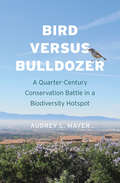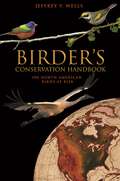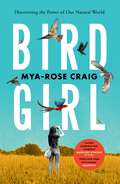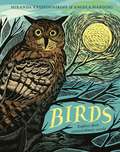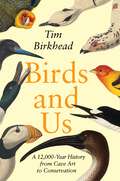- Table View
- List View
Biotechnology and Biodiversity: Biology, Biotechnology And Applications (Sustainable Development and Biodiversity #4)
by M. R. Ahuja K. G. RamawatThe purpose of this book is to assess the potential effects of biotechnological approaches particularly genetic modification on biodiversity and the environment. All aspects of biodiversity such as ecological diversity, species diversity and genetic diversity are considered. Higher organisms contain a specific set of linear DNA molecules called chromosomes and a complete set of chromosomes in an organism comprises its genome. The collection of traits displayed by any organism (phenotype) depends on the genes present in its genome (genotype). The appearance of any specific trait also will depend on many other factors, including whether the gene(s) responsible for the trait is/are turned on (expressed) or off, the specific cells within which the genes are expressed and how the genes, their expression and the gene products interact with environmental factors. The primary biotechnology which concerns us is that of genetic manipulation, which has a direct impact on biodiversity at the genetic level. By these manipulations, novel genes or gene fragments can be introduced into organisms (creating transgenics) or existing genes within an organism can be altered. Transgenics are a major area of concern, combining genes from different species to effectively create novel organisms. Current rates of disappearance of biological and cultural diversity in the world are unprecedented. Intensive resource exploitation due to social and economic factors has led to the destruction, conversion or degradation of ecosystems. Reversing these trends requires time to time assessment to integrate conservation and development.
Biotechnology and Future Cities: Towards Sustainability, Resilience and Living Urban Organisms
by Zaheer AllamThis book explores how biotechnology can lead to the reimagination of cities. In a time where the increasing adoption of technology by cities is leading to unsustainable environmental and economic concerns, biotechnology has enabled new ways of envisioning data and energy storage. Zaheer Allam thus revisits the popular concept of Smart Cities -and its associated Internet of Things (IoT) to explore how the biological sciences, coupled with technology, can be applied to cities; and in doing so, create living urban organisms on an unprecedented scale. This new concept will open up exciting avenues to providing novel solutions for climate change mitigation. The book goes on to address various potential concerns and discusses what regulatory frameworks would be needed to safely implement such a concept. It will be a useful tool for planners, policy makers and engineers as well as for researchers with in interest in the future of our cities.
Biotechnology And The New Agricultural Revolution
by Joseph J MolnarThe advent of new methods in shaping the performance characteristics of plants, animals, and microbes dramatically expands the possibilities for advances in agriculture -- a new "Green Revolution" in the offing. This book examines the impact of such developments on agricultural institutions, agribusiness, and farmers: What happens when a fundamenta
Biotechnology And The New Agricultural Revolution
by Joseph J MolnarThe advent of new methods in shaping the performance characteristics of plants, animals, and microbes dramatically expands the possibilities for advances in agriculture -- a new "Green Revolution" in the offing. This book examines the impact of such developments on agricultural institutions, agribusiness, and farmers: What happens when a fundamenta
Biotechnology Business - Concept to Delivery (EcoProduction)
by Arpita SaxenaThis book is an effort to foster the entrepreneurial spirit in young minds. It reviews a wide range of product ideas, opportunities and challenges associated with start-ups. In addition, it discusses popular molecular targets for biotechnology research / the biotech industry such as attenuated microbes, gene sequences, biomarkers, and the latest advance in the sector, CRISPR. These molecular targets can be modified for the production of sufficient quantities of food and fuel. Very often, researchers limit their focus to the proof of concept, and fail to successfully convert it into a finished product. To help young entrepreneurs avoid this pitfall, the book addresses various aspects like intellectual property regulations, commerce and management. The book’s contributing authors hail from various specialized sectors, and from around the globe. Taken together, the respective chapters are intended to overcome the borders between disciplines that otherwise rarely interact.
Biotechnology for the Environment: Strategy and Fundamentals (Focus on Biotechnology #3A)
by WalterReineke Spiros N. AgathosAt the dawn of the 21st century, biotechnology is emerging as a key enabling technology for sustainable environmental protection and stewardship. Biotechnology for the Environment: Strategy and Fundamentals captures the dynamism of environmental biotechnology as it addresses the molecular functioning of microorganisms as cleanup agents, their communal interactions in natural and polluted ecosystems, and the foundations of practical bioremediation processes. Chapters on biological pollution control in the chemical industry, biodegradation of persistent molecules (halogenated compounds, polycyclic aromatic hydrocarbons, polychlorinated biphenyls, pesticides, detergents, etc.), microbial diversity with impact on global change, bioaugmentation strategies, and sensors for ecotoxicological monitoring, will be of value to environmental scientists, engineers, and decision-makers involved in the development, evaluation, or implementation of biological treatment systems. For information on Soil Remediation, see Focus on Biotechnology volume 3B, and for information on Waste Water and Waste Gas Handling, see Focus on Biotechnology volume 3C.
Biotechnology for the Environment: Wastewater Treatment and Modeling, Waste Gas Handling (Focus on Biotechnology #3C)
by Spiros Agathos W. ReinekeAt the dawn of the 21st century, biotechnology is emerging as a key enabling technology for sustainable environmental protection and stewardship. Biotechnology for the Environment: Wastewater Treatment and Modeling, Waste Gas Handling illustrates the current technological applications of microorganisms in wastewater treatment and in the control of waste gas emissions. In the first section of the book special emphasis is placed on the use of rigorous mathematical and conceptual models for an in-depth understanding of the complex biology and engineering aspects underlying the operation of modern wastewater treatment installations. The second part addresses waste gas biofiltration, an expanding biotechnological application of microbial metabolism for air quality assurance through processes ranging from the abatement of hazardous volatile pollutants to the elimination of nuisance odors. It will be a valuable reference source for environmental scientists, engineers and decision makers involved in the development, evaluation or implementation of biological treatment systems. For more information on Strategy and Fundamentals, see Focus on Biotechnology, Volume 3A, and for more information on Soil Remediation, see Focus on Biotechnology, Volume 3B.
Biotechnology for Waste Management and Site Restoration: Technological, Educational, Business, Political Aspects (NATO Science Partnership Subseries: 2 #34)
by O. Bitchaeva C. RonneauBiotechnology for Waste Management and Site Restoration covers: waste management - solid, gaseous, liquid; site restoration - radioactivity, organics, toxic metals; educational, economic, social and business aspects; and international collaboration. International collaboration is growing apace and many concrete projects have been started. The body of knowledge is growing. Over the long term, it is envisaged that this international collaboration will result in a long-term scientific and technological strategy, new technologies and alternative solutions, and practical implementations of biotechnology for the nuclear and industrial sectors of the economy.
Biotechnology in the Sustainable Environment (Environmental Science Research #54)
by Gary S. Sayler John Sanseverino Kimberly L. DavisProceedings of a Conference held in Knoxville, Tennessee, April 14-17 1996
Biotectonics: Tectonics as the Driver of Bioregionalisation (SpringerBriefs in Evolutionary Biology)
by Malte C. Ebach Bernard MichauxTectonic plates are constantly moving, either crashing into one another creating a mosaic of mountains and shallow seas, or tearing apart and isolating large swathes of land. In both cases plate tectonics separates populations leading to the evolution of biota. Tectonics is also responsible for the destruction life, for instance when large coral reefs or shallow seas are compressed to form mountain peaks. Could recent research into these processes provide enough evidence to show that tectonics may be the ultimate driver of life on Earth? Our book delves into the current research in tectonics, particularly neotectonics, and its impact on rapid changes on biogeographical classification, also known as bioregionalisation. We also introduce a new term biotectonics that studies the impact of tectonics on biogeoregionalisation. The question we ask is how tectonics directly influences the distribution of biota in four case studies: the Mesozic and early Palaeogene Australides, which spans the Proto-Pacific coast of the South America, Antaractica and Australiasia; and the Neogene of Australia. To conclude we examine the role of neotectonics on tranistion zones and the Amazon Basin and make a case for biotectonic extinction.
Biotic Diversity and Germplasm Preservation, Global Imperatives (Beltsville Symposia in Agricultural Research #13)
by Lloyd Knutson Allan K. StonerTopics for the Beltsville Symposia are selected to highlight specific areas of research and science policy that are of concern to scientists in the Beltsville Area as well as to the general scientific community. Each sympo sium in the series is structured to provide a realistic appraisal of current findings, research progress, and relevant policy issues within the constraints established by the organizing committee. Thus, the presentations and dis cussions that have marked these symposia have had a strong appeal to the broad community of scientists. Knowledge of the diversity of living organisms is still quite limited. Since the time of Linnaeus, about 1.7 million species have been described. The actual number has been estimated between 5-50 million. Many species, land races, and strains are vanishing. Clearly, the world's scientific institutions are inadequately equipped to attain sufficient knowledge of a significant fraction of the diverse living forms. Also, efforts in the collection and preservation of germplasm of plants and animals urgently need to be strengthened. These mattes are critically important to future generations. This symposium addresses vital concerns of biotic diversity and germ plasm preservation from diverse perspectives. Many of the parts provide concrete recommendations for action, and they call attention to areas of research that must be pursued with intensity.
Biotic Homogenization
by Michael L. McKinney Julie L. LockwoodBiological homogenization is the dominant process shaping the future global biosphere. As global transportation becomes faster and more frequent, it is inevitable that biotic intermixing will increase. Unique local biotas will become extinct only to be replaced by already widespread biotas that can tolerate human activities. This process is affecting all aspects of our world: language, economies, and ecosystems alike. The ultimate outcome is the loss of uniqueness and the growth of uniformity. In this way, fast food restaurants exist in Moscow and Java Sparrows breed on Hawaii. Biological homogenization qualifies as a global environmental catastrophe. The Earth has never witnessed such a broad and complete reorganization of species distributions.
Bird Food Recipes: Storey Country Wisdom Bulletin A-137 (Storey Country Wisdom Bulletin)
by Rhonda Massingham HartSince 1973, Storey's Country Wisdom Bulletins have offered practical, hands-on instructions designed to help readers master dozens of country living skills quickly and easily. There are now more than 170 titles in this series, and their remarkable popularity reflects the common desire of country and city dwellers alike to cultivate personal independence in everyday life.
Bird Migration: A New Understanding
by John H. RappoleA fascinating and nuanced exploration of why, how, and which birds migrate.Bird migration captivates the human imagination, yet for most of us, key aspects of the phenomenon remain a mystery. How do birds sense the ideal moment to take wing, and once the epic journey has begun, how do they find their distant destinations? Fresh insights about avian movements are still constantly emerging, powered by new tools like molecular genetics and transmitter miniaturization. In this book, renowned ornithologist and author John H. Rappole reveals intriguing results of recent scientific studies on migration, explaining their importance for birders, nature lovers, and researchers alike. Debunking misconceptions about the lives of birds that have persisted for thousands of years, Rappole explores unexpected causes and previously misunderstood aspects of the annual migration cycle. From the role of migrating birds in zoonotic disease transmission to climate change's impact on migration patterns, Rappole tackles crucial questions and ensures that readers come away with a new understanding of why and how birds migrate.
Bird Migration: A New Understanding
by John H. RappoleA fascinating and nuanced exploration of why, how, and which birds migrate.Bird migration captivates the human imagination, yet for most of us, key aspects of the phenomenon remain a mystery. How do birds sense the ideal moment to take wing, and once the epic journey has begun, how do they find their distant destinations? Fresh insights about avian movements are still constantly emerging, powered by new tools like molecular genetics and transmitter miniaturization. In this book, renowned ornithologist and author John H. Rappole reveals intriguing results of recent scientific studies on migration, explaining their importance for birders, nature lovers, and researchers alike. Debunking misconceptions about the lives of birds that have persisted for thousands of years, Rappole explores unexpected causes and previously misunderstood aspects of the annual migration cycle. From the role of migrating birds in zoonotic disease transmission to climate change's impact on migration patterns, Rappole tackles crucial questions and ensures that readers come away with a new understanding of why and how birds migrate.
Bird on Fire: Lessons from the World's Least Sustainable City
by Andrew RossPhoenix, Arizona is one of America's fastest growing metropolitan regions. It is also its least sustainable one, sprawling over a thousand square miles, with a population of four and a half million, minimal rainfall, scorching heat, and an insatiable appetite for unrestrained growth and unrestricted property rights. In Bird on Fire, eminent social and cultural analyst Andrew Ross focuses on the prospects for sustainability in Phoenix--a city in the bull's eye of global warming--and also the obstacles that stand in the way. Most authors writing on sustainable cities look at places that have excellent public transit systems and relatively high density, such as Portland, Seattle, or New York. But Ross contends that if we can't change the game in fast-growing, low-density cities like Phoenix, the whole movement has a major problem. Drawing on interviews with 200 influential residents--from state legislators, urban planners, developers, and green business advocates to civil rights champions, energy lobbyists, solar entrepreneurs, and community activists--Ross argues that if Phoenix is ever to become sustainable, it will occur more through political and social change than through technological fixes. Ross explains how Arizona's increasingly xenophobic immigration laws, science-denying legislature, and growth-at-all-costs business ethic have perpetuated social injustice and environmental degradation. But he also highlights the positive changes happening in Phoenix, in particular the Gila River Indian Community's successful struggle to win back its water rights, potentially shifting resources away from new housing developments to producing healthy local food for the people of the Phoenix Basin. Ross argues that this victory may serve as a new model for how green democracy can work, redressing the claims of those who have been aggrieved in a way that creates long-term benefits for all. Bird on Fire offers a compelling take on one of the pressing issues of our time--finding pathways to sustainability at a time when governments are dismally failing in their responsibility to address climate change.
Bird on Fire: Lessons from the World's Least Sustainable City
by Andrew RossPhoenix, Arizona is one of America's fastest growing metropolitan regions. It is also its least sustainable one, sprawling over a thousand square miles, with a population of four and a half million, minimal rainfall, scorching heat, and an insatiable appetite for unrestrained growth and unrestricted property rights. In Bird on Fire, eminent social and cultural analyst Andrew Ross focuses on the prospects for sustainability in Phoenix--a city in the bull's eye of global warming--and also the obstacles that stand in the way. Most authors writing on sustainable cities look at places that have excellent public transit systems and relatively high density, such as Portland, Seattle, or New York. But Ross contends that if we can't change the game in fast-growing, low-density cities like Phoenix, the whole movement has a major problem. Drawing on interviews with 200 influential residents--from state legislators, urban planners, developers, and green business advocates to civil rights champions, energy lobbyists, solar entrepreneurs, and community activists--Ross argues that if Phoenix is ever to become sustainable, it will occur more through political and social change than through technological fixes. Ross explains how Arizona's increasingly xenophobic immigration laws, science-denying legislature, and growth-at-all-costs business ethic have perpetuated social injustice and environmental degradation. But he also highlights the positive changes happening in Phoenix, in particular the Gila River Indian Community's successful struggle to win back its water rights, potentially shifting resources away from new housing developments to producing healthy local food for the people of the Phoenix Basin. Ross argues that this victory may serve as a new model for how green democracy can work, redressing the claims of those who have been aggrieved in a way that creates long-term benefits for all. Bird on Fire offers a compelling take on one of the pressing issues of our time--finding pathways to sustainability at a time when governments are dismally failing in their responsibility to address climate change.
Bird versus Bulldozer: A Quarter-Century Conservation Battle in a Biodiversity Hotspot
by Audrey MayerAn examination of the struggle to conserve biodiversity in urban regions, told through the story of the threatened coastal California gnatcatcher The story of the rare coastal California gnatcatcher is a parable for understanding the larger ongoing struggle to conserve biodiversity in regions confronted with intensifying urban development. Because this gnatcatcher depends on vanishing coastal sage scrub in Southern California, it has been regarded as a flagship species for biodiversity protection since the early 1990s. But the uncertainty of the gnatcatcher’s taxonomic classification—and whether it can be counted as a “listable unit” under the Endangered Species Act—has provoked contentious debate among activists, scientists, urban developers, and policy makers. Synthesizing insights from ecology, environmental history, public policy analysis, and urban planning as she tracks these debates over the course of the past twenty-five years, Audrey L. Mayer presents an ultimately optimistic take on the importance of much-neglected regional conservation planning strategies to create sustainable urban landscapes that benefit humans and wildlife alike.
Birddog: Philosophy and practice of seismic data quality supervision
by J.S. RoyThis book describes the methods and attributes required for the compe tent quality control of the data acquisition of a seismic exploration crew operating on land. Although the book is concerned mainly with explo ration for oil and gas reservoirs, and all the topics that are discussed in it are centred on that target, the material is applicable to other areas of seismic exploration such as civil engineering and the search for other minerals. The book comprises the distillation of more than thirty years' experience in geophysical exploration in all its aspects and in many parts of the world. Seismic data acquisition quality supervision is one aspect of geophysical exploration which, although of great importance, has had, so far as the writer is aware, no textbook devoted to it. It is hoped that it will be of interest to anyone who is engaged, in whatever capacity, in geophysical exploration and will help them to attain their goal, which is illustrated in Fig. 1. 1. The term birddog is colloquial in the geophysical exploration industry. It is a convenient shorthand title to describe the person whose full title is, and who acts as, the data acquisition quality control supervisor on a field seismic exploration crew. The term is used also to describe the person who is the client's representative on the field crew. In practice the same person performs both functions on behalf of the client.
Birder's Conservation Handbook: 100 North American Birds at Risk
by Jeffrey V. WellsUntil now there has been no single, comprehensive resource on the status of North America's most threatened birds and what people can do to help protect them. Birder's Conservation Handbook is the only book of its kind, written specifically to help birders and researchers understand the threats while providing actions to protect birds and their habitats. Jeffrey Wells has distilled vast amounts of essential information into a single easy-to-use volume-required reading for anyone who loves birds and wants to ensure they are protected. At-a-glance species accounts cover in detail North America's one hundred most at-risk birds; each account is beautifully illustrated by today's top bird artists. The text includes status, distribution, ecology, threats, conservation actions and needs, and references. A distribution map accompanies each entry. Chapters discuss birds as indicators of environmental health, the state of North American bird populations, major conservation issues, and initiatives now underway to improve the health of North America's birds. Birder's Conservation Handbook is an indispensable resource for birdwatchers, researchers, naturalists, and conservationists. Reading it will inspire you to become an active steward of our birds and the habitats we share. A comprehensive guide to North America's one hundred most at-risk birds and how to protect them Compact and easy to use, with beautiful illustrations and data organized for convenient, at-a-glance reference Detailed species accounts, including distribution maps Practical advice on conservation Information on leading conservation agencies and resources
Birder's Conservation Handbook (PDF): 100 North American Birds at Risk
by Jeffrey V. WellsUntil now there has been no single, comprehensive resource on the status of North America's most threatened birds and what people can do to help protect them. Birder's Conservation Handbook is the only book of its kind, written specifically to help birders and researchers understand the threats while providing actions to protect birds and their habitats. Jeffrey Wells has distilled vast amounts of essential information into a single easy-to-use volume-required reading for anyone who loves birds and wants to ensure they are protected. At-a-glance species accounts cover in detail North America's one hundred most at-risk birds; each account is beautifully illustrated by today's top bird artists. The text includes status, distribution, ecology, threats, conservation actions and needs, and references. A distribution map accompanies each entry. Chapters discuss birds as indicators of environmental health, the state of North American bird populations, major conservation issues, and initiatives now underway to improve the health of North America's birds. Birder's Conservation Handbook is an indispensable resource for birdwatchers, researchers, naturalists, and conservationists. Reading it will inspire you to become an active steward of our birds and the habitats we share. A comprehensive guide to North America's one hundred most at-risk birds and how to protect them Compact and easy to use, with beautiful illustrations and data organized for convenient, at-a-glance reference Detailed species accounts, including distribution maps Practical advice on conservation Information on leading conservation agencies and resources
Birdgirl: ‘Lyrical, poignant and insightful.’ Margaret Atwood
by Mya-Rose CraigDiscover Mya-Rose Craig's moving and life-affirming memoir about family, searching for rare birds, and the power of our natural world.'Lyrical, poignant and insightful' MARGARET ATWOOD (on Twitter)'Filled with hope and energy' GuardianIn her memoir, Mya-Rose Craig and her family travel the world in search of rare birds and astonishing landscapes. But a shadow moves with them, too - her mother's deepening mental health crisis. In the face of this struggle, the Craigs turn to nature again and again, and every time it offers joy and stillness.On these journeys, Mya-Rose also witnesses the inequality and destruction we are inflicting on our fragile planet. And so, through the simple, mindful act of looking for birds, she becomes ever more determined to campaign for all our survival.'A delightful account of a young life devoted to birding - and the fight to save birds and the places they live' Stephen Moss* Winner of a Somerset Maugham Award ** Longlisted for the Wainwright Prize for Conservation Writing ** Longlisted for the Jhalak Prize *
Birds: Explore Their Extraordinary World
by Miranda KrestovnikoffA heavily designed and stunning look at the many birds of the sky--perfect for fans of Botanicum.From the bitter cold polar regions to the lush tropics, birds have found incredible ways to adapt and survive anywhere. White-winged diuca finches nest high upon freezing glaciers and mightly peregrine falcons circle skyscrapers in busy cities. Look up! What birds can do is extraordinary. The statuesque golden eagle spots prey from miles away. You can tell what time of day an owl hunts by looking at the color of its eyes. With its long, muscular legs, the secretary bird has a powerful kick that is enough to kill large prey like snakes and hares. Discover which bird is the fastest, the smallest, the smartest, the most colorful and more in this nonfiction compendium, complete with descriptions from wildlife expert Miranda Krestovnikoff and stunning linocuts from artist Angela Harding.
Birds: Explore Their Extraordinary World
by Miranda KrestovnikoffA heavily designed and stunning look at the many birds of the sky--perfect for fans of Botanicum.From the bitter cold polar regions to the lush tropics, birds have found incredible ways to adapt and survive anywhere. White-winged diuca finches nest high upon freezing glaciers and mightly peregrine falcons circle skyscrapers in busy cities. Look up! What birds can do is extraordinary. The statuesque golden eagle spots prey from miles away. You can tell what time of day an owl hunts by looking at the color of its eyes. With its long, muscular legs, the secretary bird has a powerful kick that is enough to kill large prey like snakes and hares. Discover which bird is the fastest, the smallest, the smartest, the most colorful and more in this nonfiction compendium, complete with descriptions from wildlife expert Miranda Krestovnikoff and stunning linocuts from artist Angela Harding.
Birds and Us: A 12,000-Year History from Cave Art to Conservation
by Tim BirkheadFrom award-winning author and ornithologist Tim Birkhead, a sweeping history of the long and close relationship between birds and humansSince the dawn of human history, birds have stirred our imagination, inspiring and challenging our ideas about science, faith, art, and philosophy. We have worshipped birds as gods, hunted them for sustenance, adorned ourselves with their feathers, studied their wings to engineer flight, and, more recently, attempted to protect them. In Birds and Us, award-winning writer and ornithologist Tim Birkhead takes us on a dazzling epic journey through our mutual history with birds, from the ibises mummified and deified by Ancient Egyptians to the Renaissance fascination with woodpecker anatomy—and from the Victorian obsession with egg collecting to today’s fight to save endangered species and restore their habitats.Spanning continents and millennia, Birds and Us chronicles the beginnings of a written history of birds in ancient Greece and Rome, the obsession with falconry in the Middle Ages, and the development of ornithological science. Moving to the twentieth century, the book tells the story of the emergence of birdwatching and the field study of birds, and how they triggered an extraordinary flowering of knowledge and empathy for birds, eventually leading to today’s massive worldwide interest in birds—and the realization of the urgent need to save them.Weaving in stories from Birkhead’s life as scientist, including far-flung expeditions to wondrous Neolithic caves in Spain and the bustling guillemot colonies of the Faroe Islands, this rich and fascinating book is an unforgettable account of how birds have shaped us, and how we have shaped them.
